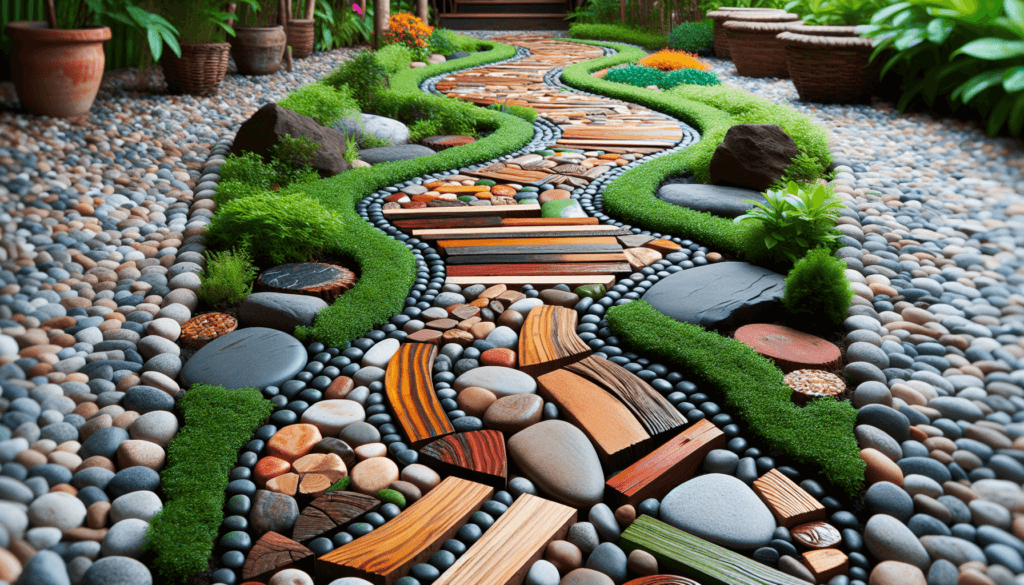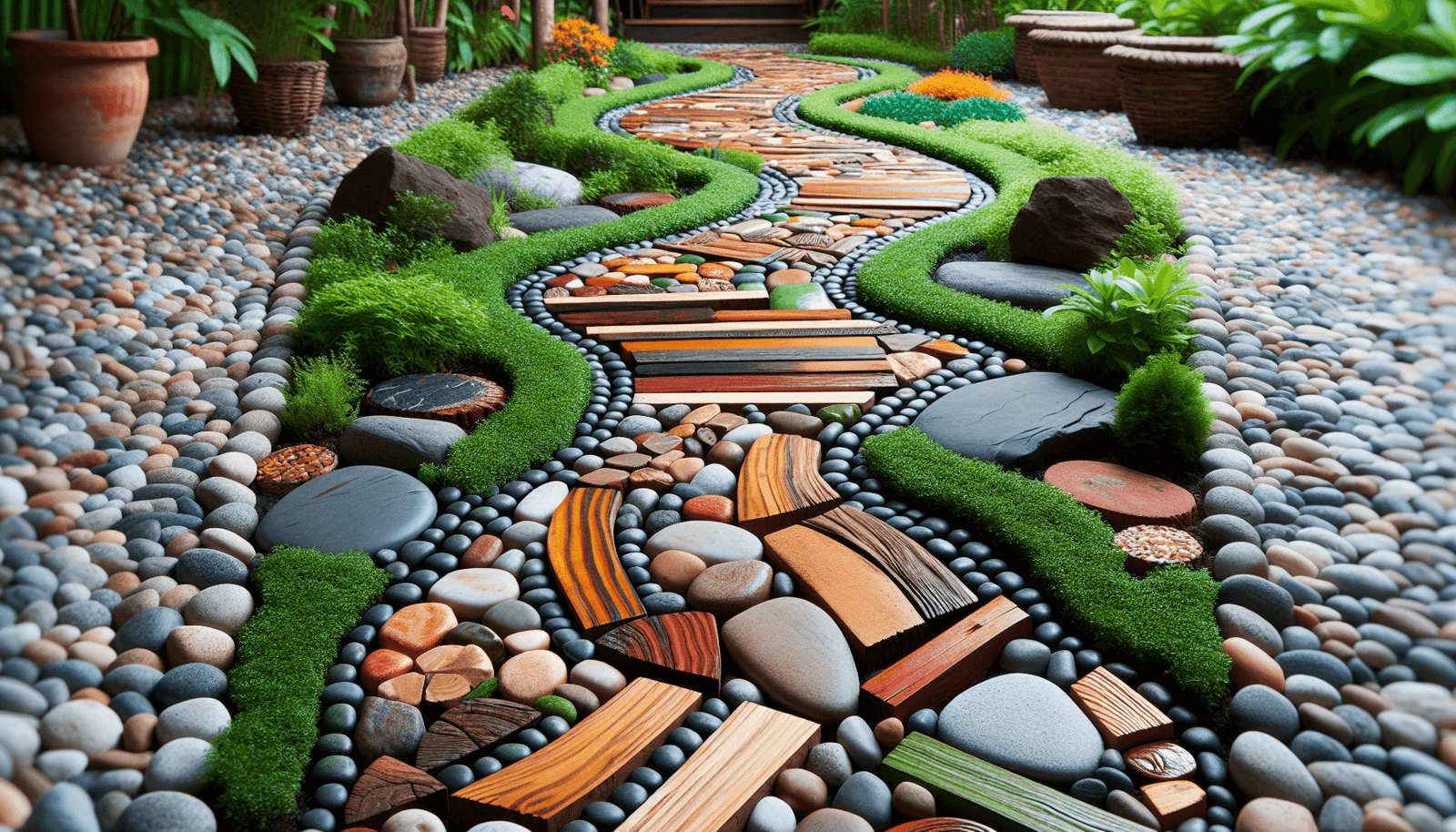Imagine strolling through a beautiful garden on a peaceful summer evening, the scent of flowers in the air and the sound of birdsong all around you. Now picture walking along a pathway that not only enhances the natural beauty of the garden, but also showcases your commitment to the environment. In this article, we will explore the top 10 eco-friendly ways to create stunning garden pathways that are both sustainable and visually captivating. From using recycled materials to incorporating native plants, these creative ideas will inspire you to transform your garden into a sustainable oasis.

1. Gravel Pathway
Gravel pathways are a popular and eco-friendly choice for garden pathways. Not only do they add a natural and rustic charm to your outdoor space, but they also offer several benefits. Firstly, gravel pathways are relatively easy to install, making them a great DIY project. Additionally, they are cost-effective compared to other materials like concrete or pavers. Gravel pathways also provide good drainage, preventing water from pooling and causing damage to plants or structures. Furthermore, gravel is a sustainable material that can be easily sourced, reducing the environmental impact of your pathway project.
Creating a gravel pathway is a simple process that can be accomplished in a few steps. First, you’ll need to mark out the desired path and remove any existing grass or vegetation. Next, excavate the area to a depth of about 4-6 inches, ensuring a level base. Afterward, it’s essential to lay a weed barrier fabric to prevent weed growth and maintain the pathway’s appearance. Once the fabric is in place, pour and spread the gravel evenly across the pathway, aiming for a thickness of about 2-3 inches. Finally, compact the gravel using a tamper or roller to ensure a stable surface.
Maintaining a gravel pathway is relatively easy. Regularly rake the gravel to prevent uneven distribution and ensure a smooth walking surface. Remove any debris, such as leaves or twigs, as they can make the pathway slippery and potentially hazardous. Over time, gravel may shift or become compacted, so it’s important to replenish it occasionally by adding a fresh layer. Additionally, keeping the edges of the pathway defined with edging materials will help prevent the gravel from spilling onto surrounding spaces and maintain a neat appearance.
2. Stepping Stone Pathway
Stepping stone pathways offer a charming and natural look to your garden while being an eco-friendly option. These pathways consist of carefully placed stones that create a visually appealing and functional walkway. One of the key advantages of a stepping stone pathway is the versatility it offers. You can choose stones of various shapes, sizes, and colors to create a unique and personalized pathway that complements your garden’s aesthetics.
To create a stepping stone pathway, start by marking out the path and removing any vegetation. Dig holes for each stone, making sure they are evenly spaced and at a depth that allows the stones to sit flush with the ground. Place the stones in the holes, ensuring they are level and stable. It may be necessary to add or remove soil to achieve the desired height. Finally, fill in the gaps between the stones with gravel or a ground cover like moss or thyme, adding a touch of greenery to the pathway.
Maintaining a stepping stone pathway does require some regular care. Inspect the stones periodically to ensure they remain stable and level. If any stones become wobbly, simply adjust the soil or gravel beneath them to secure them in place. Remove any weeds or vegetation that may grow between the stones to keep the pathway tidy. Additionally, keep the stones clean by regularly sweeping or hosing them down to remove dirt, leaves, and other debris.

3. Mulch Pathway
Mulch pathways are an excellent choice for eco-conscious gardeners looking to add a natural aesthetic to their outdoor space. Mulch is a readily available and sustainable material that helps improve soil moisture retention, suppress weed growth, and prevent erosion. The use of mulch also reduces the need for chemical weed killers, making it a healthier choice for both your garden and the environment.
Creating a mulch pathway is a straightforward process. Start by marking out the path you want the mulch to cover, and remove any grass or vegetation within the designated area. It’s recommended to install a weed barrier fabric before spreading the mulch, as this will further inhibit weed growth. Once the fabric is in place, spread the mulch evenly across the pathway to a depth of about 2 inches, ensuring that it covers the entire area. Rake the mulch to create a smooth and level surface, and you’re all set.
Maintaining a mulch pathway is relatively low-maintenance. Regularly inspect the pathway for any weeds and promptly remove them to prevent them from taking root. To keep the mulch in place and maintain its appearance, gently rake it periodically. Mulch may break down over time, so it’s good to replenish the layer if it becomes thin. Additionally, be mindful of heavy rainfall or wind, as they can sometimes cause the mulch to shift or wash away. Adding an edging material, such as stones or timbers, can help keep the mulch contained and prevent erosion.
4. Wood Chip Pathway
Wood chip pathways offer a natural and rustic charm to your garden while being an environmentally friendly choice. Wood chips are a byproduct of the lumber industry and can often be sourced locally. By repurposing this waste material, you are reducing the demand for new resources, making it an eco-conscious option.
Creating a wood chip pathway is a relatively simple task. Begin by outlining the desired path and removing any vegetation or grass. If necessary, level the ground to ensure a smooth surface. Next, lay down a weed barrier fabric to prevent weed growth and maintain the pathway’s appearance. Once the fabric is secure, spread a layer of wood chips evenly across the pathway. Aim for a depth of about 2-3 inches to provide adequate coverage. Finally, use a rake to smooth out the wood chips and create an even surface.
Maintaining a wood chip pathway is relatively easy. Regularly inspect the pathway for any weeds and remove them promptly. To maintain the pathway’s appearance, periodically rake the wood chips to even out any uneven areas or displacement caused by foot traffic. It’s also important to replenish the wood chips as needed to maintain the desired thickness. Additionally, be mindful of any areas where the wood chips may erode or wash away due to heavy rainfall or wind. Adding a border or edging material can help prevent this and provide a more defined pathway.

5. Paver Pathway
Paver pathways offer a durable and visually appealing option for garden pathways. In addition to their aesthetic charm, pavers also provide excellent stability and longevity. They are available in a variety of materials, including concrete, brick, and natural stone, allowing you to choose one that best suits your garden’s style.
Creating a paver pathway requires a bit more effort and skill compared to some other options. Begin by marking out the path and digging a trench to a depth of about 6-8 inches. This trench will serve as the foundation for the pavers. Next, add a layer of compacted gravel to the trench to provide stability and ensure proper drainage. Once the gravel is in place, set the pavers on top, arranging them in the desired pattern or design. Use a level to ensure they are even, and adjust the gravel as needed. Finally, fill the gaps between the pavers with sand or a paver jointing compound, and sweep off any excess material.
Maintaining a paver pathway primarily involves periodic cleaning and inspections. Regularly sweep or rinse off the surface to remove any dirt, leaves, or debris that may accumulate. If any weeds grow between the pavers, carefully remove them by hand or using a weed killer, taking care to not damage the pavers. Additionally, inspect the pathway for any cracks or loose pavers, and reposition or replace them as needed. Sealing the pavers every few years can help protect them from stains and prolong their lifespan.
6. Concrete Pathway
Concrete pathways offer a clean and modern look to your garden, and they are a popular choice due to their durability and ease of maintenance. Concrete is a versatile and long-lasting material that can withstand heavy foot traffic and various weather conditions. By choosing concrete for your pathway, you are opting for a sustainable option that will require minimal upkeep over time.
Creating a concrete pathway typically involves pouring concrete into a pre-determined form or mold. Start by marking out the path and excavating the area to the desired depth, typically around 4-6 inches. It’s important to ensure the excavated area is level and compacted. Next, create wooden forms along the edges of the pathway to contain the concrete. These forms should be secured firmly. Once the forms are in place, pour the concrete into the designated area, ensuring it is spread evenly and leveled with a screed or float. Allow the concrete to cure according to the manufacturer’s instructions before removing the forms and using the pathway.
Maintaining a concrete pathway is relatively straightforward. Regularly sweep or hose off the surface to remove any dirt, leaves, or debris. If any stains occur, such as oil or rust, there are various concrete cleaners available to treat them. Avoid using harsh chemicals or abrasive cleaners, as they can damage the concrete. Additionally, inspect the pathway for any cracks or damage, and repair them promptly to prevent further deterioration. Sealing the concrete every few years can also help prolong its lifespan and protect it from stains and wear.

7. Grass Pathway
Grass pathways offer a unique and natural alternative to traditional hardscaped pathways. These pathways incorporate living grass, creating a visually striking and environmentally friendly option. Grass pathways can blend seamlessly with your garden, providing a soft and inviting walkway while promoting a sense of tranquility.
Creating a grass pathway requires careful planning and maintenance. Start by marking out the desired path and removing any vegetation or grass from the designated area. Next, prepare the soil by loosening it and removing any rocks or debris. It’s essential to provide adequate drainage for the grass, so consider incorporating a layer of sand or gravel beneath the soil. Once the soil is ready, lay sod or plant grass seeds according to the type of grass you prefer. Water the area regularly and provide proper care to ensure healthy grass growth. Depending on the climate and type of grass, regular mowing and occasional fertilization may be required.
Maintaining a grass pathway can be more labor-intensive compared to other options. Regular mowing is necessary to keep the grass at a manageable height and prevent it from encroaching onto surrounding areas. Edging the pathway with a physical barrier, such as stones or metal edging, can help maintain the defined edges of the grass pathway. It’s important to water the grass adequately, especially during dry periods, to ensure its health and prevent it from drying out. Additionally, be cautious of foot traffic on the grass pathway, as excessive use can cause wear and tear. Resting the grass periodically or providing alternate pathways can help alleviate this issue.
8. Pebble Pathway
Pebble pathways add a touch of elegance and natural beauty to your garden. With their smooth and decorative appearance, pebble pathways offer a unique visual appeal and blend well with various garden styles. Pebbles come in a range of colors and sizes, allowing you to create a pathway that suits your personal taste.
Creating a pebble pathway requires proper preparation and attention to detail. Begin by marking out the path and removing any grass, vegetation, or debris. Next, excavate the area to a depth of about 4-6 inches, ensuring a level base. It’s important to provide adequate drainage for the pathway, so consider using a layer of crushed rock or gravel beneath the pebbles. Once the base is prepared, spread a layer of landscaping fabric to suppress weed growth and maintain the pathway’s appearance. Finally, pour and spread the pebbles evenly across the pathway, aiming for a thickness of about 1-2 inches. Use a rake or broom to smooth out the pebbles and create an even surface.
Maintaining a pebble pathway is relatively low-maintenance. Regularly rake the pebbles to prevent uneven distribution and ensure a smooth walking surface. Remove any debris, such as leaves or twigs, as they can make the pathway slippery and potentially hazardous. Over time, pebbles may shift or become displaced, so it’s important to periodically rake or level them to maintain a stable surface. Additionally, be cautious of weeds that may grow between the pebbles and promptly remove them to keep the pathway tidy.

9. Mosaic Pathway
Mosaic pathways bring an artistic touch to your garden, showcasing intricate designs and patterns. By creating a mosaic pathway, you can express your creativity and add a unique focal point to your outdoor space. Mosaics are made by arranging small pieces of colored glass, ceramic, or stone in a mortar or adhesive to form a cohesive design.
Creating a mosaic pathway is a detailed and time-intensive process. Start by outlining the desired path and removing any existing vegetation or debris. Next, prepare a solid foundation by leveling the ground and making sure it is sturdy and free of cracks. Once the foundation is ready, create a mortar or adhesive mixture suitable for outdoor use and apply it to the pathway area. Begin arranging the mosaic pieces according to your design, pressing them firmly into the mortar or adhesive. Pay close attention to spacing and alignment to ensure a visually appealing result. Allow the mosaic to dry and cure according to the manufacturer’s instructions before using the pathway.
Maintaining a mosaic pathway involves regular cleaning and care. Avoid using abrasive cleaners or tools that can damage the mosaic. Instead, gently sweep or rinse off the surface to remove dirt and debris. Periodically inspect the pathway for any loose or damaged mosaic pieces, and repair them promptly to preserve the integrity of the design. Applying a sealant specifically designed for mosaics can help protect the surface from stains and weathering, ensuring its longevity and vibrant appearance.
10. Recycled Materials Pathway
Recycled materials pathways offer an environmentally friendly and creative way to repurpose and provide new life to discarded materials. By using recycled materials, you can reduce waste, lower your carbon footprint, and create a unique pathway that showcases your resourcefulness.
Creating a recycled materials pathway requires some imagination and resourcefulness. Start by determining the type of recycled materials you would like to incorporate into your pathway. This can include items such as broken tiles, old bricks, discarded glass bottles, or even reclaimed wood. Once you have gathered your materials, begin by marking out the desired path and removing any existing grass or vegetation. Next, prepare the pathway area by leveling the ground and ensuring a stable base. Lay the recycled materials according to your design, arranging them securely and evenly. Fill in any gaps with mortar or adhesive suitable for the chosen materials. Allow the pathway to dry and cure before using it.
Maintaining a recycled materials pathway varies depending on the materials used. Regularly inspect the pathway for any loose or damaged components and repair or replace them as needed. Clean the pathway using appropriate methods for the specific materials, avoiding cleaners or tools that may damage them. Applying sealants or protective coatings, if applicable, can help enhance the durability and longevity of the recycled materials. It’s essential to regularly inspect the pathway for any signs of wear or deterioration, ensuring it remains safe and visually appealing.
In conclusion, there are various eco-friendly options available for creating garden pathways. Whether you prefer the natural charm of gravel or wood chips, the versatility of pavers or stepping stones, or the artistic touch of mosaics and recycled materials, there is a pathway that can suit your unique style and environmental values. Consider the benefits of each option, the process of creating them, and the necessary maintenance to choose the pathway that best meets your needs and contributes to a sustainable and beautiful garden.


